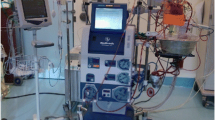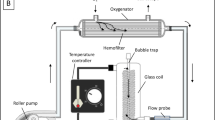Abstract
In this study we used Visible Heart® methodologies featuring cyclic temperature modulation of porcine hearts in order to establish characteristic temperature responses. This isolated and perfused model is a more predictable and modifiable analog for human heart preservation and isolates the response of the cardiac tissue. We comprehensively monitored isolated porcine hearts undergoing temperature change and demonstrated optimization of isolated cardiac function under mild hypothermia. We tracked metrics of cardiac function as continuous variables during temperature changes (~ 31 to 39 °C), eliciting a well-defined reduction in metabolic demand and in heart rate modulation. Optimization of function appeared to occur around 34.7 ± 0.9 °C (n = 13). Cardiac response was further investigated in the presence of active pacing in order to assess pacing capture and the heart’s functional response without a means of regulating rate. Our results may have direct clinical implications for emerging heart preservation methods prior to transplantation, as well as benefits for investigators using isolated heart models for preclinical device testing. Clinically, this porcine model is a basis for finding new ways to extend the window of viability for transplantable organs, thereby restoring or improving graft function and potentially enhancing recipient outcomes.









Similar content being viewed by others
References
Alam HB, Duggan M, Li Y, Spaniolas K, Liu B, Tabbara M, Demoya M, Sailhamer EA, Shults C, Velmahos GC (2008) Putting life on hold—for how long? Profound hypothermic cardiopulmonary bypass in a swine model of complex vascular injuries. J Trauma 64:912–922. https://doi.org/10.1097/TA.0b013e3181659e7f
Ardehali A, Esmailian F, Deng M, Soltesz E, Hscich E, Naka Y, Mancini D, Camacho M, Zucker M, Leprince P, Pandera R, Kobashigawa J (2015) Ex-vivo perfusion of donor hearts for human heart transplantation (PROCEED II): a prospective, open-label, multicentre, randomized non-inferiority trial. Lancet 385:2577–2584. https://doi.org/10.1016/S0140-6736(15)60261-6
Barcroft J, Izquierdo JJ (1931) The relation of temperature to the pulse rate of the frog. J Physiol 71:145–155
Bayegan K, Janata A, Frossard M, Holzer M, Sterz F, Losert UM, Laggner AN, Behringer W (2008) Rapid non-invasive external cooling to induce mild therapeutic hypothermia in adult human-sized swine. Resuscitation 76:291–298. https://doi.org/10.1016/j.resuscitation.2007.07.006
Bergmann SR, Clark RE, Sobel BE (1979) An improved isolated heart preparation for external assessment of myocardial metabolism. Am J Phys 236:H644–H661. https://doi.org/10.1152/ajpheart.1979.236.4.H644
Bing RJ, Siegel A, Vitale A, Balboni F, Sparks E, Taeschler M, Klapper M, Edwards S (1953) Metabolic studies on the human heart in vivo. I. Studies on carbohydrate metabolism of the human heart. Am J Med 15:284–296
Blinks JR (1956) Positive chronotropic effect of increasing right atrial pressure in the isolated mammalian heart. Am J Phys 186:299–303. https://doi.org/10.1152/ajplegacy.1956.186.2.299
Braunwald E (1971) Control of myocardial oxygen consumption: physiologic and clinical considerations. Am J Cardiol 27:416–432
Breathnach CS (1969) Henry Newell Martin (1848-1893). A pioneer physiologist. Med Hist 13:271–279
Bünger R, Haddy FJ, Querengässer A, Gerlach E (1975) An isolated Guinea pig heart preparation with in vivo like features. Pflugers Arch 353:317–326
Chinchoy E, Soule CL, Houlton AJ, Gallagher WJ, Hjelle MA, Laske TG, Morissette J, Iaizzo PA (2000) Isolated four-chamber working swine heart model. Ann Thorac Surg 70:1607–1614
Erlinge D, Götberg M, Noc M, Lang I, Holzer M, Clemmensen P, Jensen U, Metzler B, James S, Bøtker HE, Omerovic E, Koul S, Engblom H, Carlsson M, Arheden H, Östlund O, Wallentin L, Klos B, Harnek J, Olivecrona GK (2015) Therapeutic hypothermia for the treatment of acute myocardial infarction-combined analysis of the RAPID MI-ICE and the CHILL-MI trials. Ther Hypothermia Temp Manag 5:77–84. https://doi.org/10.1089/ther.2015.0009
Freed DH, White CW (2015) Donor heart preservation: straight up, or on the rocks? Lancet 385:2552–2554. https://doi.org/10.1016/S0140-6736(15)60614-6
García Sáez D, Elbetanony A, Lezberg P, Hassanein A, Bowles CT, Popov AF, Zych B, Sabashnikov A, Mohite P, Simon AR (2015) Ex vivo heart perfusion after cardiocirculatory death; a porcine model. J Surg Res 195:311–314. https://doi.org/10.1016/j.jss.2014.12.039
Harding SE, Vescovo G, Kirby M, Jones SM, Gurden J, Poole-Wilson PA (1988) Contractile responses of isolated adult rat and rabbit cardiac myocytes to isoproterenol and calcium. J Mol Cell Cardiol 20:635–647
Herring MJ, Dai W, Hale SL, Kloner RA (2015) Rapid induction of hypothermia by the ThermoSuit System profoundly reduces infarct size and anatomic zone of no reflow following ischemia–reperfusion in rabbit and rat hearts. J Cardiovasc Pharmacol Ther 20:193–202. https://doi.org/10.1177/1074248414535664
Iaizzo PA, Laske TG (2002) The Visible Heart™: the collaborative development and use of this educational tool by the University of Minnesota and Medtronic. Engineering in Medicine and Biology, 2002. 24th Annual Conference and Annual Fall Meeting of the Biomedical Engineering Society EMBS/BMES Conference, 2002. Proceedings of the Second Joint 3:2625–2627. https://doi.org/10.1109/IEMBS.2002.1053460
Janse MJ, van Capelle FJ, Freud GE, Durrer D (1971) Circus movement within the AV node as a basis for supraventricular tachycardia as shown by multiple microelectrode recording in the isolated rabbit heart. Circ Res 28:403–414
Jose AD, Stitt F, Collison D (1970) The effects of exercise and changes in body temperature on the intrinsic heart rate in man. Am Heart J 79:488–498
Keon WJ, Hendry PJ, Taichman GC, Mainwood GW (1988) Cardiac transplantation: the ideal myocardial temperature for graft transport. Ann Thorac Surg 46:337–341
Knowlton FP, Starling EH (1912) The influence of variations in temperature and blood-pressure on the performance of the isolated mammalian heart. J Physiol 44:206–219
Langendorff O (1895) Untersuchungen am überlebenden Säugethierherzen. Archiv für die gesammte Physiologie des Menschen und der Thiere 61:291–332
Laske TG, Skadsberg ND, Iaizzo PA (2002) Comparative in vivo and ex vivo pacing and sensing performance study using isolated four-chamber working swine heart model. Engineering in Medicine and Biology, 2002. 24th Annual Conference and Annual Fall Meeting of the Biomedical Engineering Society EMBS/BMES Conference, 2002. Proceedings of the Second Joint 2:1264–1265. https://doi.org/10.1109/IEMBS.2002.110637
Laske TG, Skadsberg ND, Iaizzo PA (2005) A novel ex vivo heart model for the assessment of cardiac pacing systems. J Biomech Eng 127:894–898
Laske TG, Vieau SA, Skadsberg ND, Iaizzo PA (2005) High pacing impedances: are you over torquing your leads? Pacing Clin Electrophysiol 28:883–891. https://doi.org/10.1111/j.1540-8159.2005.00192.x
Li Y, Ristagno G, Guan J, Barbut D, Bisera J, Weil MH, Tang W (2012) Preserved heart rate variability during therapeutic hypothermia correlated to 96 hrs neurological outcomes and survival in a pig model of cardiac arrest. Crit Care Med 40:580–586. https://doi.org/10.1097/CCM.0b013e31822ef9e4
Lin H, Mo A, Zhang F, Huang A, Wen Z, Ling S, Hu Y, Zhou Y, Lu C (2010) Donor heart preservation in an empty beating state under mild hypothermia. Ann Thorac Surg 89:1518–1523. https://doi.org/10.1016/j.athoracsur.2010.02.008
McEwen LM (1956) The effect on the isolated rabbit heart of vagal stimulation and its modification by cocaine, hexamethonium and ouabain. J Physiol 31:678–689
Rolfes C, Howard S, Goff R, Iaizzo PA (2012) Localized drug delivery for cardiothoracic surgery. In: Cagini L (editor) Current concepts in general thoracic surgery. InTech Open Access Chapter, pp. 279–304. https://doi.org/10.5772/48577
Schwarzl M, Steendijk P, Huber S, Truschnig-Wilders M, Obermayer-Pietsch B, Maechler H, Pieske B, Post H (2011) The induction of mild hypothermia improves systolic function of the resuscitated porcine heart at no further sympathetic activation. Acta Physiol 203:409–418. https://doi.org/10.1111/j.1748-1716.2011.02332.x
Sigg DC, Coles JA Jr, Gallagher WJ, Oeltgen PR, Iaizzo PA (2001) Opioid preconditioning: myocardial function and energy metabolism. Ann Thorac Surg 72:1576–1582
Suga H, Goto Y, Igarashi Y, Yasumura Y, Nozawa T, Futaki S, Tanaka N (1988) Cardiac cooling increases Emax without affecting relation between O2 consumption and systolic pressure-volume area in dog left ventricle. Circ Res 63:61–71
Suh GJ, Kwon WY, Kim KS, Lee HJ, Jeong KY, Jung YS, Lee JH (2014) Prolonged therapeutic hypothermia is more effective in attenuating brain apoptosis in a swine cardiac arrest model. Crit Care Med 42:e132–e142. https://doi.org/10.1097/CCM.0b013e3182a668e4
Taylor MJ, Baicu SC (2010) Current state of hypothermic machine perfusion preservation of organs: the clinical perspective. Cryobiology 60:S20–S35. https://doi.org/10.1016/j.cryobiol.2009.10.006
Tissier R, Chenoune M, Ghaleh B, Cohen MV, Downey JM, Berdeaux A (2010) The small chill: mild hypothermia for cardioprotection? Cardiovasc Res 88:406–414. https://doi.org/10.1093/cvr/cvq227
Weisser J, Martin J, Bisping E, Maier LS, Beyersdorf F, Hasenfuss G, Pieske B (2001) Influence of mild hypothermia on myocardial contractility and circulatory function. Basic Res Cardiol 96:198–205
Zhang C, Gao G, Jiang H, Lv CG, Zhang BL, Zie MS, Zhang ZL, Yu L, Zhang XF (2012) Effects of environmental hypothermia on hemodynamics and oxygen dynamics in a conscious swine model of hemorrhagic shock. World J Emerg Med 3:128–134. https://doi.org/10.5847/wjem.j.1920-8642.2012.02.009
Funding
Research was funded by a Medtronic research contract.
Author information
Authors and Affiliations
Corresponding author
Ethics declarations
Conflict of interest
Paul Iaizzo has a research contract with Medtronic. Brian Howard is currently employed by Medtronic.
Ethical approval
All applicable international, national, and/or institutional guidelines for the care and use of animals were followed. All procedures performed in studies involving animals were in accordance with the ethical standards of the Institutional Animal Care and Use Committee at the University of Minnesota.
Additional information
Publisher’s note
Springer Nature remains neutral with regard to jurisdictional claims in published maps and institutional affiliations.
Rights and permissions
About this article
Cite this article
Howard, B.T., Iaizzo, P.A. Induced functional modulations of isolated large mammalian hearts. Pflugers Arch - Eur J Physiol 471, 1095–1101 (2019). https://doi.org/10.1007/s00424-019-02277-0
Received:
Revised:
Accepted:
Published:
Issue Date:
DOI: https://doi.org/10.1007/s00424-019-02277-0




